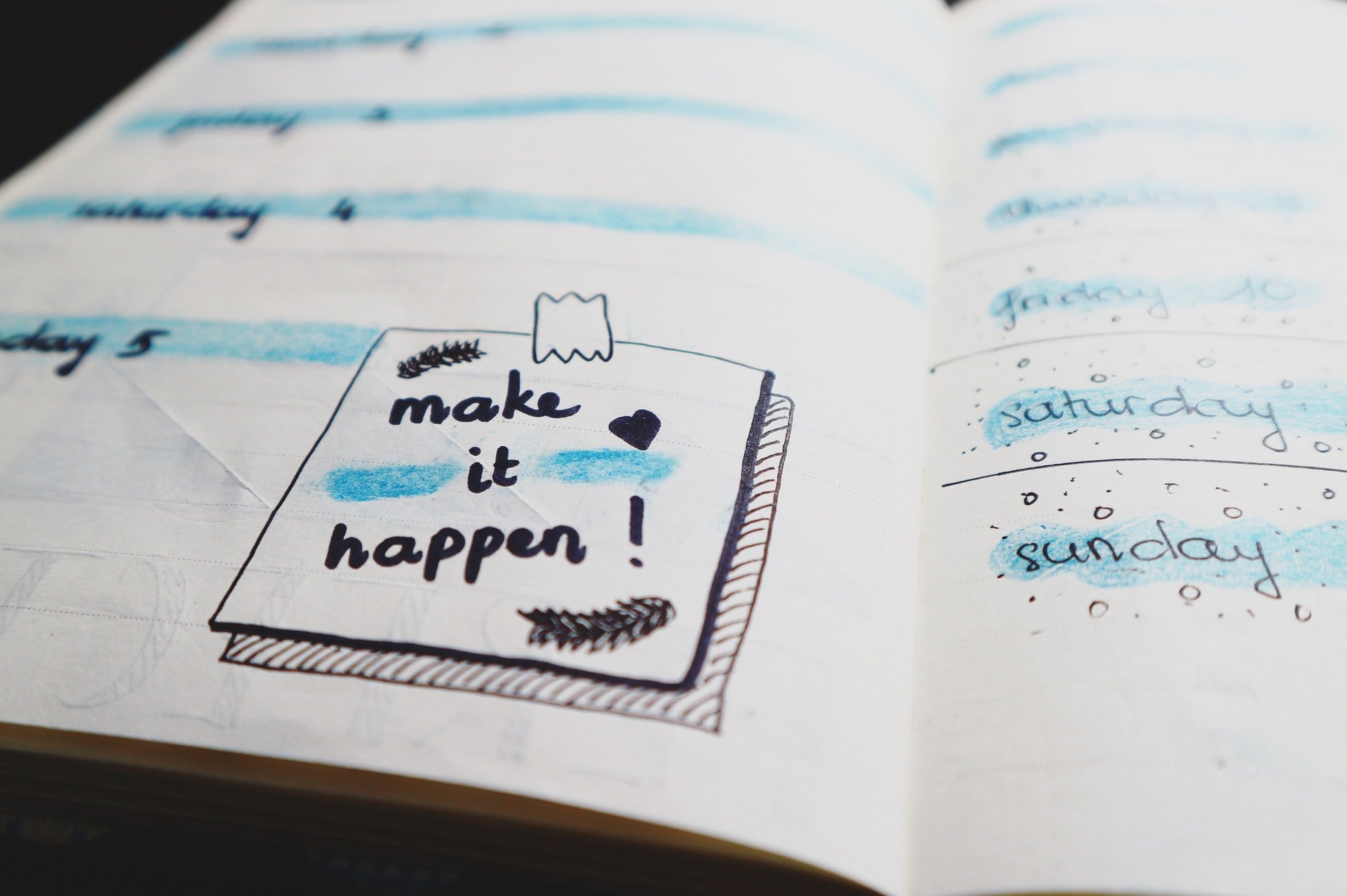We Need a Plan...
You don’t have to be a fan of aphorisms to agree that the fearless writer and pilot, Antoine de Saint-Exupéry, was onto something when he said, “A goal without a plan is just a wish”. Spelling out hopes and dreams that give our imagined futures more “oomph” and direction is the easy part, but reckoning with the sacrifice, dedication, and vulnerability necessary to be “goal-driven” can leave even the most ambitious go-getters treading the waters of wishful thinking. It is also easy to get stuck in a cycle of admiring the problem; wondering whether our goals are profound enough to pursue (less attainment/more connection) and tinkering around to ensure a goal is measurable and actionable enough to be deemed S.M.A.R.T. If we’re not careful, we might even find ourselves analyzing the cost benefits and creating a task force to look into the problem. Before we know it, the goal that was once a burgeoning beam of light on the horizon has morphed into something dreadfully akin to a talking point, or worse, a variable to explore down the road. Yikes! So, when our focus is directed towards a goal in the realm of education that is so fundamental and admirable and downright correct that the United Nations happens to be working towards it for all of Humankind?! what can we do to prevent the key to achieving it from getting lost, mislabeled as a run-of-the-mill initiative, or spending years languishing in the purgatory of proposed education reforms?
The Goal: An Inclusive and Equitable Education for All
The goal in question, aptly described as fundamental, admirable, and downright correct, ranks fourth on the list of seventeen Sustainable Development Goals the United Nations is leading the world in achieving by 2030: Quality Education; An Inclusive and Equitable Education for All. For the sake of brevity, it’s best to leapfrog over the “why” of this goal and assume that anyone would agree it deserves every head nod and hyperbole we can muster. This goal… this goal is predicated on such a long and varied list of worthy “why’s”, who can count?
So, as we move closer to the “how” terrain of achieving the goal of ensuring an inclusive and equitable education for all, it might be helpful to clear up any confusion about Inclusion. According to the United Nations, an Inclusive Education can be understood as:
- a fundamental human right of all persons with disabilities.
- a means to achieve the full realization of the right to education and an indispensable means of realizing other human rights.[i]
- a principle that values the well-being of all students, respects their inherent dignity and acknowledges their needs and their ability to make a contribution to society.
- a process that necessitates a continuing and pro-active commitment to the elimination of barriers impeding the right to education, together with changes to culture, policy and practice of regular schools to accommodate all students.
In 2016, the UN marked the tenth anniversary of the Convention for Rights of People with Disabilities (which has been ratified by 157 countries to date) by issuing General Comment No.4 “The Right to Inclusive Education”. For learning leaders, General Comment No. 4 is a blueprint for how to create the conditions necessary to ensure an Inclusive Education for all learners. It also serves as an advocacy resource for families. So often, they are sold a wolf in sheep’s clothing when in reality, their child is learning in the harmful and archaic model of education known as Integration. If learners are required to “fit in” and a school fails to “… value the well-being of all students, respects their inherent dignity and autonomy… and their ability to effectively be included in and contribute to society,” it is failing to abide by the Convention’s Principles of Inclusive Education.
How? Achieving the Goal
The “How” of achieving the goal of ensuring an equitable and inclusive education for all learners is multifaceted and complex, to say the least. Yet, thinkers, think tanks, and governments share the same refrain; Universal Design for Learning (UDL). The United Nations have even given clear directives...
“The Committee encourages States parties to apply the Universal Design for Learning (UDL) approach... Curricula must be conceived, designed and applied to meet and adjust to the requirements of every student, and provide appropriate educational responses. Standardized assessments must be replaced by flexible and multiple forms of assessments and recognition of individual progress towards broad goals that provide alternative routes for learning.”
The World Economic Forum, The International Disability Alliance, and authors of the seminal guide to creating inclusive schools that is translated into 40 languages, “The Index for Inclusion”, Mel Ainscow and Tony Booth, all agree that systems, skills, and beliefs that define Universal Design for Learning are fundamental to ensure an equitable and inclusive education for all learners. We can’t forget the U.S. lawmakers who wrote and voted the Every Student Succeeds Act into law. There we see that three-letter acronym, UDL; defined, endorsed, and peppered throughout the law as the “How” that it is.
The successful implementation of Universal Design for Learning depends on shifts in mindsets and dismantling modes and models of education as we know them. If we take time to unpack the systems, skills, and beliefs of UDL, quotes from Paulo Freire and Bell Hooks are stirred from hibernation to flood our Conscientização… UDL is just that revolutionary. The United Nations did us all a favor by spelling out that “transforming the education system” is part of the package. UDL compels us to reimagine how we define and measure success for the 21st century learner and if we think long and hard, what hasn’t been reimagined in the past decades? The mismatch of our traditional models of education and forecasts of the future have been sending tremors through society for years. Choosing UDL as our shared path to an equitable and inclusive future is an opportune time to proclaim that the traditional systems and methods in education are ineffective and misguided; not the students.
Before we cue the high-fives and Hallelujahs, we must contend with that behemoth of a question that got us here in the first place. What can we do to prevent the key to ensuring an Inclusive and Equitable Education for All, Universal Design for Learning, from getting lost in the shuffle, mislabeled as a run of the mill initiative, and spending years in “Proposed Education Reforms” purgatory?
Perhaps prevention is too optimistic, because too often you will find UDL has been over-simplified, underfunded, and outshined by quick fix alternatives that appeal to our consumer instincts but do little to honor the students they are supposedly designed to empower… You only have to glance at the date the ESSA Act was passed (2015, by the way) and count how many times UDL appears (numerous) to conclude that UDL is tiptoeing around the precipice of edu-purgatory. How can we center UDL as that burgeoning beam of light on our horizon, our shared refrain to “All Means All”, and exalt it as the necessary means with which we can and must ensure every learner’s Human Right to an Inclusive Education? Well, we need a plan... because until the systems, skills, and beliefs that define Universal Design for Learning seeps into the soil from which our curriculum grows, until it is embraced by all leaders and school communities as Tier One and Plan A for every student, until UDL appears in the bold faced print of agendas and lands smack dab in the center of ongoing professional learning, our “Aha” moment about authentic Inclusive Education has yet to happen. And if we’ve taken one nugget of wisdom from this past year, it’s that we don’t have time to waste with wishful thinking.
Booth, T., & Ainscow, M. (2002). Index for Inclusion. Disability Equality in Education. https://www.eenet.org.uk/resources/docs/Index%20English.pdf
UNICEF. (n.d.). Inclusive Education: Understanding Article 24 of the Convention on the Rights of Persons with Disabilities. UNICEF. https://www.unicef.org/eca/sites/unicef.org.eca/files/IE_summary_accessible_220917_0.pdf
United Nations Committee on the Rights of Persons with Disabilities. (2016, November 25). General comment No. 4 (2016) on the right to inclusive education. United Nations Human Rights Office of the High Commissioner. https://www.ohchr.org/en/hrbodies/crpd/pages/gc.aspx
United Nations Convention on the Rights of Persons with Disabilities. (n.d.). Convention on the Rights of Persons with Disabilities (CRPD). Department of Economic and Social Affairs Disability.
World Economic Forum. (n.d.). Inclusive Design. Global Issues. https://intelligence.weforum.org/topics/a1G0X0000057IniUAE?tab=publications



